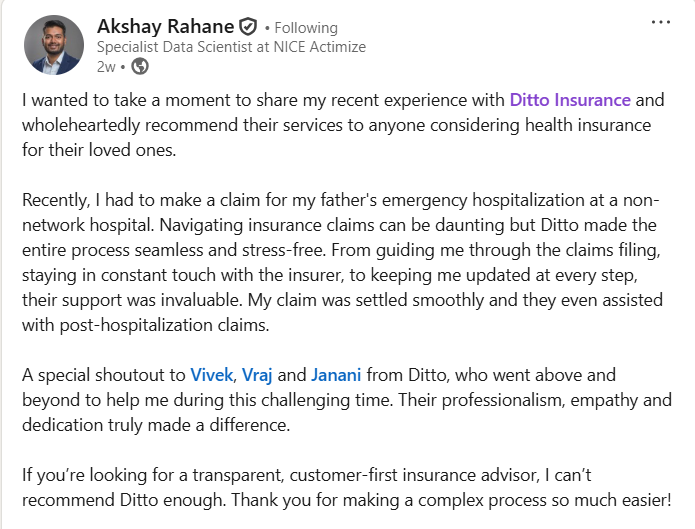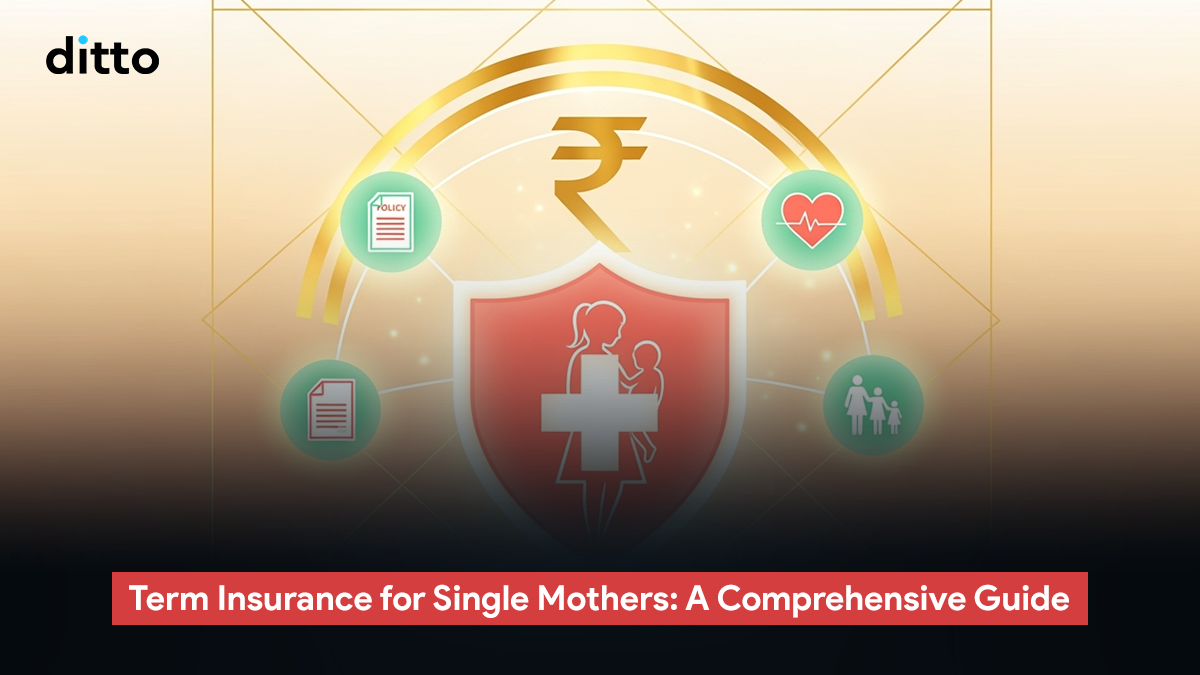| What Is Term Insurance for Single Mothers? Term insurance is a pure protection life insurance plan. You pay a fixed premium, and if something happens to you during the policy term, your nominee (usually your child, or if they’re a minor, a guardian you appoint) receives the sum assured. For single mothers, this payout often becomes the only shield of defence for the child’s financial future, as it may be used to cover school fees, higher education, living expenses, or even childcare support. Unlike insurance + investment products, term plans focus only on protection, making them affordable yet powerful for single parents. |
It goes without saying that being a single mother comes with immense responsibility, emotionally, financially, and practically. From managing day-to-day expenses to planning for long-term goals like a child’s education and healthcare, everything rests on your shoulders. In such cases, having a term insurance plan becomes undeniably essential.
At Ditto, we help thousands of individuals make the right insurance decisions every month. For this guide, we have drawn information from IRDAI regulations, policy wordings, and our claim support experience to break down what term insurance means for single mothers, how it works, and the right way to choose a plan.
Book a FREE Consultation with Ditto’s Advisors Today and Secure Your Child’s Future — No Spam, No Salesmen.
How Does Term Insurance for Single Mothers Work?
At its core, term insurance for single mothers works just like any other term insurance plan. However, women generally have a longer life expectancy and lower mortality risk compared to men. Insurers reflect this by offering premiums that are often 10–15% lower to encourage greater participation of women in financial protection.
- You choose a cover amount (say ₹1-2 crore).
- Pay an annual premium (which stays fixed through the term).
- If you pass away during the policy term, the insurer pays the sum assured to your nominee.Nominee choice is crucial here:
- If your child is a minor, you must appoint an adult legal guardian to receive and manage the payout till the child attains majority.
- If your child is above 18, you can directly nominate them.
Alternatively, you can nominate your parents or siblings if you prefer.
| Did you know? HDFC Life, along with its term plan, offers a free comprehensive wellness program that provides emotional and psychological counselling to help nominees cope with grief and bereavement for up to one year after the policyholder’s demise. |
How To Buy Term Insurance For A Single Mother?
Buying a term plan as a single mother isn’t very different from buying a regular plan — but the stakes are higher since your child’s entire financial security may depend on it. Here’s what to keep in mind:
1.Underwriting Factors
Your premium and eligibility for term insurance are determined through underwriting, where insurers assess risks based on age, health, smoking habits, BMI, occupation type, location, medical test results, and even existing insurance cover. Each of these factors helps insurers evaluate your risk profile and price your policy accordingly.
2.Choose riders without compromise
- Critical Illness Rider – covers major illnesses like cancer, heart disease, etc and replaces the income lost due to illness. However, keep in mind that a Critical Illness Rider is not a replacement for comprehensive health insurance.
- Disability Rider – ensures income protection if an accident leaves you unable to work.
- Waiver of Premium – if you’re critically ill or disabled, future premiums are waived, but the policy continues.
3.Opt for a higher cover
- Since there may not be a second source of income, choose a cover amount on the higher side (at least 15–20x your annual income).
- This ensures a safety buffer for long-term needs like higher education, marriage, or inflation.
For ease, start with Ditto’s Term Insurance Calculator to estimate how much coverage you should opt for.
4.Keep a buffer for expenses
Don’t just cover basic survival costs; factor in inflation, liability (current and future), child’s dreams such as education, marriage, purchasing a home, etc. and emergency reserves.
5.Pick the right policy tenure
Ideally, your term plan should cover you until your key financial responsibilities are complete—such as when your child becomes financially independent, major loans are repaid, or you approach retirement. Extending beyond this may not be necessary, as your protection needs reduce once dependents no longer rely on your income.
6. Check insurer reliability
- Look beyond just the claim settlement ratio (CSR).
- Check Annual business volumes, solvency ratios – whether the insurer is profitable and sustainable.
- Review Complaint Volume – low complaints = smoother customer experience.
- This ensures that when the time comes, your nominee will actually get the money without unnecessary hassle.
Example of Term Insurance Cover Calculation for a Single Mother Profile
Mother: 34 years old
Child: 6 years old
Current household expenses: ₹50,000/month (₹6,00,000/year)
Home loan: ₹20 lakh
Education goal: ₹25 lakh (today’s cost)
Step 1: Expenses till the child is 25Today’s annual expense is ₹6 lakh. But expenses rise by ~6% every year (inflation). Over 19 years, the family will need about ₹98 lakh to sustain the same lifestyle.
Step 2: Future education cost
The college fund needed at age 18 is not just today’s ₹25 lakh. Education costs grow faster, ~8% annually. In 12 years, that ₹25 lakh will balloon to about ₹63 lakh.
Step 3: Add liabilities, subtract savings
Add home loan: ₹20 lakh
Step 4: Total protection needed
98L (expenses) + 63L (education) + 20L (loan) = ₹1.81 crore.
Add a small 10% cushion for emergencies → Target Sum Assured ≈ ₹2 crore.
Payout Design (for ₹2 crore cover)
Lump sum (40%) = ₹80 lakh upfront → clears loan + creates safety net.
Monthly income (60%) = ₹1.2 crore spread over 20 years. (which will amount to 75k-80k per month after discounting it at 5%)
This way, the child’s education fund is safeguarded, daily expenses are taken care of, and the money isn’t exhausted too early.
Popular Term Plans for Single Mothers (Ditto’s Cut)
| Before we discuss the list, here’s how we decide what plans to feature. At Ditto, every term insurance plan goes through our six-point evaluation framework. It doesn’t mean these are the only good plans, but that they stand out after being scored across all six pillars. You can learn more about how we evaluate health insurance plans here. |
| Plan | Key Features |
|---|---|
| HDFC LIFE Click2Protect Supreme | Accidental Death Benefit, Disability & Critical Illness Premium Waiver, Accidental Total Permanent Disability rider, Inflation-linked cover increase, Critical Illness Cover (60 illnesses) |
| ICICI Prudential IProtect Smart Plus | Accidental Death Benefits, Life Stage Benefit (increased coverage after milestones like marriage/childbirth), Critical Illness Cover (60 illnesses), Premium Break & |
| AMLI Smart Term Plan Plus | - Accidental Death & Dismemberment Benefit, Critical Illness Cover (up to 64 illnesses), Regular or Smart Cover variants (1.5X coverage for first 15 years), Women's Perks (Lifeline Plus & premium discounts), Waiver of Premium on Disability or Critical Illness |
| BALIC E-Touch II | - Accidental Death Benefit, Terminal Illness cover, Life Stage Benefit (increased coverage after marriage, childbirth, or home loan), Critical Illness Coverage (60 illnesses), Inbuilt Waiver of Premium on Permanent Disability (accident-related) |
| TATA AIA Sampoorna Raksha Promise | - Accidental Death Benefit, Critical Illness Coverage (40 illnesses), Accidental Total & Permanent Disability benefit, Waiver of Premium on Critical Illness/Permanent Disability, Life Stage Benefit |
Premiums of Term Plans for Single Mothers
| Plan | Age: 25 (non-smoker, 1 crore, till 65) |
Age: 30 (non-smoker, 1.5 crore, till 70) |
Age: 35 (smoker, 2 crore, till 70) |
Age: 40 (non-smoker, 2 crore, till 65) |
Age: 45 (non-smoker, 2.5 crores, till 70) |
|---|---|---|---|---|---|
| HDFC LIFE Click2Protect Supreme | ₹9303 | ₹17842 | ₹52421 | ₹29900 | ₹59754 |
| ICICI Prudential IProtect Smart Plus | ₹8733 | ₹15241 | ₹40805 | ₹28807 | ₹58609 |
| AMLI Smart Term Plan Plus | ₹8385 | ₹16812 | ₹43616 | ₹29248 | ₹59098 |
| BALIC E-Touch II | ₹9044 | ₹14719 | ₹44742 | ₹26960 | ₹46988 |
| TATA AIA Sampoorna Raksha Promise | ₹8744 | ₹16450 | ₹47788 | ₹29460 | ₹60154 |
Note on Term Insurance Quotes:
- Riders are not included in these quotes.
- These premiums are for a healthy female profile.
How to Choose the Right Term Insurance for Single Mothers? (Ditto’s take)
Think of term insurance as a financial safety net. For single mothers, it’s less about numbers and more about making sure your child’s future is safe, no matter what today brings. But here’s the catch: insurers only issue term insurance if you have a stable source of income. If you’re a homemaker without personal earnings, pure term plans are difficult to avail.
So, assuming you’re a working single mother—whether divorced, widowed, or a single woman who has adopted—a regular term plan is your best bet. Not just that, riders like Critical Illness (CI) and Waiver of Premium (WOP) are critical. CI provides a payout on diagnosis of major illnesses, while WOP ensures your policy continues even if you can’t pay premiums due to illness or disability.
| Profile of Woman | Eligibility & Plan Options | Notes |
|---|---|---|
| Working Women (Salaried / Self-Employed) with proper income documents (Payslips, ITR) | Standard term plans from major insurers (HDFC Life, ICICI Pru, Axis Max, etc.) | If documents aren’t available, fallback options include ICICI iProtect Super or Bajaj iSecure II. |
| Women with Unearned Income (Capital Gains / Rental Income) | Women-centric plans like Bajaj Allianz Superwoman Plan | Coverage linked to financial capacity, not active employment. |
| Housewives/Self-Employed with financial surrogates (investment portfolio, healthy bank balance, strong credit card limits) | Bajaj Allianz Superwoman Plan | Provides limited protection; issued based on surrogate financial proof rather than direct income. |
Note - This is not an exhaustive list, term plans from various insurers are available on the basis of financial surrogates.
Some women-centric policies exist—like Bajaj Allianz Superwoman Term or TATA AIA SRP Shubh Shakti—but they come with significant limitations (low/compulsory CI cover or riders tied to the husband’s death). For stronger protection, Ditto recommends comprehensive mainstream plans.
| BALIC Superwoman | Tata Shubh Shakti | |
|---|---|---|
| Composition | Repackaged Existing term plan E-touch II | Repackaged Existing term plan, Sampoorna Raksha Promise, and Health Buddy program |
| USP | Child care rider - Lumpsum and a monthly income payable to child upon demise or accidental total & permanent disability of mother. Compulsory Critical Illness Cover of 60 CIs including women specific cancers, cardiac, neuro etc. Health Management Services - Diet & nutrition, psychologist consultations, comprehensive free health check-up once a year, discounts on pharmacy and unlimited teleconsults (perceived value of ₹36,500 p.a) Women are eligible for insurance cover basis unearned income as well (rental income, capital gain or income surrogates like avg bank balance, SIP/Investment portfolio, credit card limit etc) |
Child Education Protection Rider – Ensures your child’s education expenses are taken care of until they turn 21/25 through structured payouts, even in your absence. Waiver of Premium on Spouse’s Accidental Death – Future premiums are waived off if the husband dies in an accident, ensuring the mother’s cover continues without financial strain. Premium Break During Pregnancy – Unique option to pause premium payments for up to 12 months during pregnancy, providing financial relief without losing cover. Single Mother Discount – Lifetime premium discount (1%) exclusively for single mothers, making long-term protection more affordable. Health Buddy Enhance – Access to annual health check-ups, women-specific screenings (PCOS, PAP smear, anemia), vaccinations (HPV, flu, hepatitis, shingles), chronic condition management (diabetes, hypertension), unlimited teleconsults, pharmacy/lab discounts, and dental wellness services. Lower Premiums for Women – Women enjoy up to 15% lower premiums compared to men, leading to significant long-term savings. |
Government support: Alongside insurance, widows and distressed women may access schemes like the Indira Gandhi National Widow Pension Scheme (IGNWPS) and state-specific pensions (e.g., Delhi’s Widow Pension, UP’s Krishna Kutir Home, West Bengal’s Widow Pension). These don’t replace term insurance but provide a basic social safety net.
Why Consider Ditto for Health Insurance?
At Ditto, we’ve assisted over 8,00,000 customers with choosing the right health insurance policy. Here’s why customers like Akshay love us:

✅No-Spam & No Salesmen
✅Rated 4.9/5 on Google Reviews by 15,000+ happy customers
✅Backed by Zerodha
✅Dedicated Claim Support Team
✅100% Free Consultation
You can book a FREE consultation. Slots are running out, so make sure you book a call now!
Term Insurance for Single Mothers: Final Thoughts
For single mothers, term insurance is the backbone of financial security for their child. With the right coverage and essential riders, you can safeguard education, healthcare, and day-to-day stability even in your absence.
While government schemes offer limited support, they can’t replace the comprehensive protection of a robust term plan. Choose wisely, aim for higher cover, and focus on insurer reliability. At the end of the day, the right term insurance ensures that your child’s future is never left to chance.
FAQs
What are the riders I can add to my term plan for single mothers?
For single mothers, riders are essential as they add extra protection. Critical Illness Rider gives a lump-sum payout on diagnosis of major illnesses, while Accidental Disability Rider secures income in case of permanent disability. The Waiver of Premium Rider ensures your policy continues even if you can’t pay premiums due to illness or disability.
What are the things to consider before buying a term insurance plan for single mothers?
Before buying, focus on getting a higher cover amount (15–20x your income) and appointing a reliable nominee or guardian. Always add critical riders like CI, Disability, and WOP. Beyond that, check insurer metrics such as CSR, annual business, solvency, and complaint volume to ensure smooth claim settlement. Finally, make sure the premium is sustainable long-term.
Can a homemaker single mother buy term insurance?
For homemaker single mothers without a steady income, getting a pure term plan is difficult since insurers link coverage to earning capacity. However, some women-centric policies like Bajaj Allianz Superwoman or TATA AIA Shubh Shakti extend limited cover based on financial surrogates such as rental income, investments, or healthy bank balances. While these aren’t as comprehensive as standard term plans for working women, they still provide a valuable layer of protection for the child’s future. Endowment plans and other such life insurance plans are the last resort if term plans, even simple ones like Saral Jeevan Bima, are not available.
How much coverage should a single mother take?
A good rule of thumb is to take 15–20 times your annual income as cover. For example, if you earn ₹10 lakh annually, aim for ₹1.5–2 crore. This ensures enough funds to cover your child’s education, healthcare, and daily living expenses, while also factoring in inflation and unforeseen costs over the long term. If you’re confused, feel free to use Ditto’s Term Insurance Coverage Calculator.
Last updated on:







